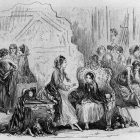The Best Short Story I Read in a Lit Mag This Week: “Dark Season” by Maya Sonenberg
Over the last few decades, it has become more and more common to find mythical narratives such as fairy tales alongside realist fiction in academic and mainstream literary journals and magazines. More publications have also opened up to stories that blend storytelling elements that previously were dismissed as “genre” into the style du jour, realism. Maya Sonenberg, in her story, “Dark Season,” from the latest issue of the Pacifica Literary Review, does a masterful job of weaving together elements of both fairy tales and realism in order to create a new, hybrid reality that in ways feels more true to contemporary life than perhaps either style could aspire to on its own.
When we meet the protagonist—under a section subtitled, “The Dungeon”—he is referred to only as “the boy” and his father as “the king.” Not naming characters is an accepted technique of fables and fairy tales, and we’d be firmly in that mythical tradition, except that woven into these approaches to characterization and storytelling are contemporary details, which push the story elsewhere:
At recess, he kicked a ball around the school yard with his buddies and when it found the back of the net, he shouted, ‘GOOOOAAAAAAL,’ the way he heard the announcers do on the Spanish language soccer broadcasts he listened to at night. He didn’t know where the voices came from…His father, the king…sometimes told him of such places, even claimed to have come from one himself.
The play-by-play reference situates us firmly into contemporary life through content—soccer—as well as style—the spelling and capitalization of the announcer’s cry. Where characters referred to simply as “the boy” and “the king” invite the whole tradition of fairy tales to help provide their characterizations, the soccer descriptions draw their power from the their relation to the present milieu.
In this section Sonenberg also alludes to the isolation of the boy, and that his father in fact grew up in the sort of place these voices on the radio came from. We soon discover that the boy and the kingdom are isolated from the rest of the world, and in this way the island kingdom they live in serves as a stronghold of the past, because its stories remain untested by the larger world.
There is a battle going on here between past and present, between myth and reality, and it’s being waged through storytelling. By the time we enter the second section, subtitled, “Tower,” Sonenberg reveals that the boy has grown, and he’s now weary of his sheltered life as prince. He’s being lured by another island, “glimmering across the straight,” which his tutor warns him is nothing more than a mirage.
His aunts told him stories about it nevertheless: a sorceress lived there who could turn men into pigs; deep caverns there were stuffed full of treasure, just like his stocking at Christmas; two rocks off the coast were always rumbling toward each other and away again. But when they told him these stories, their mouths twitched in a way that meant they were trying not to laugh, or he heard their husbands guffaw from where they sat by the fire, reading The Sporting News or Popular Mechanics or Psychology Today, and he knew not to believe them.
This dichotomy between the ancient and the modern deepens further when, after the king flees the country, leaving the boy with the throne, the boy also escapes to that shimmering island across the sea. There he finds the woman/sorceress, who Sonenberg describes in consciously mythical generalities—“The woman was of indeterminate age, indeterminate size, indeterminate beauty as all beauty is indeterminate…”—as well as with precise, contemporary strokes:
Other mornings, despite the power work-outs, grapefruit and kale diets, and Retin-A prescriptions, she huddled over her morning coffee wrapped in a faded terry cloth, hiding her soft breasts and the loose skin on her neck.
Throughout “Dark Season,” meaning is a function of style; how the boy understands the world and his self depend on which particular way Sonenberg describes the events. By the end of the story, as the boy/prince and then the woman/sorceress begin to tire of each other, we get the sense that they are both struggling to understand how to makes sense of themselves and the world amidst so many possible, competing narratives, each claiming authority. In this way, I think the story achieves a reality much closer to our own. A multitude of narratives are constantly vying for our allegiance in our present techno-global age. It’s a struggle Sonenberg employs every element of craft to present.



